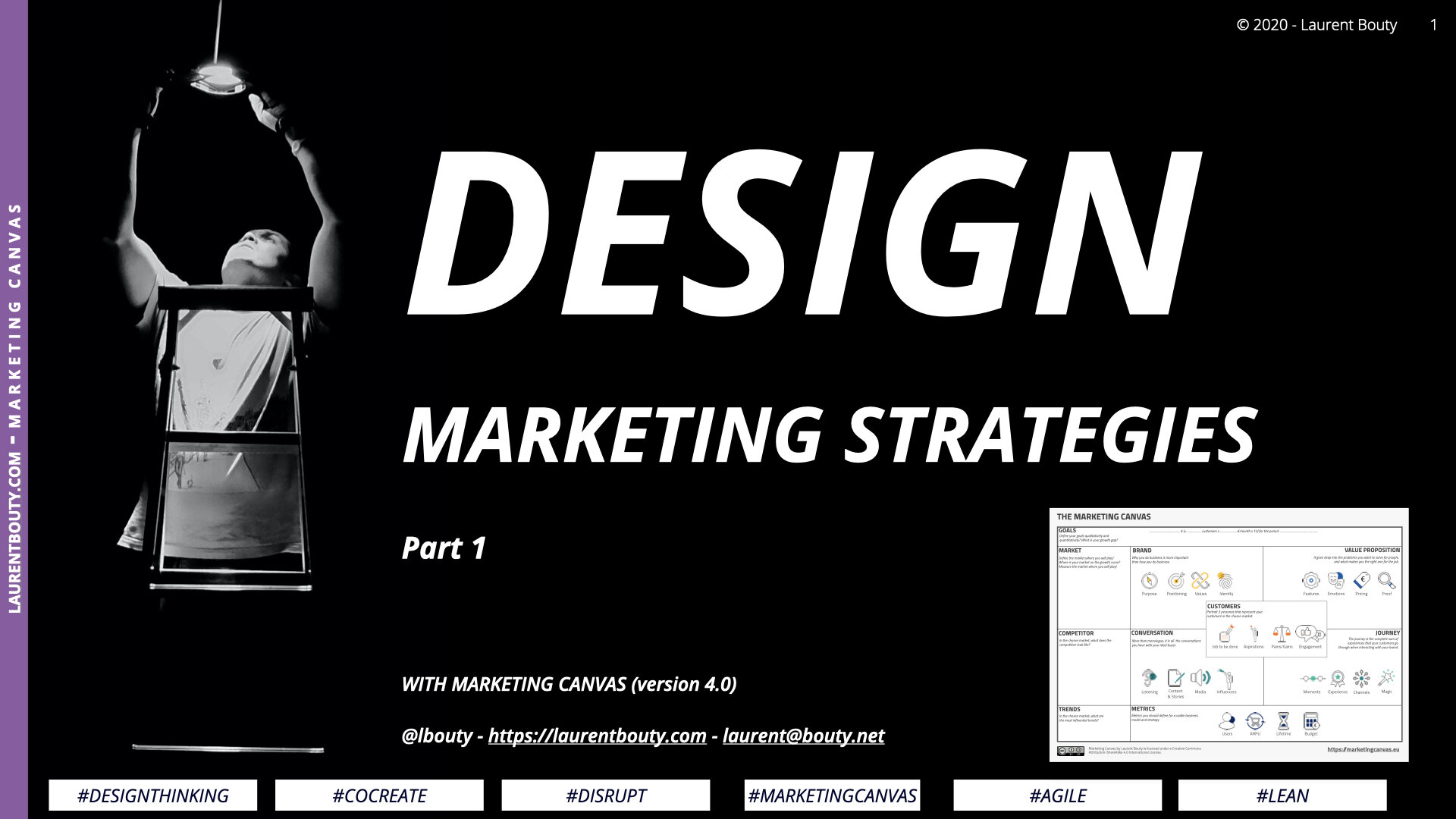Last update: 15/6/2023
In a nutshell
This article offers an extensive guide on how to harness the power of content and stories in your marketing strategy, following the renowned Marketing Canvas framework by Laurent Bouty. From understanding the significance of content in attracting and retaining customers, to choosing the right tools, and translating your content into actions - the article comprehensively covers it all. It further discusses how to evaluate and continuously improve your content and stories, ensuring they reflect your organization's goals and meet users' needs. Lastly, the article provides a practical use-case example to illustrate the application of these concepts. Whether you're a non-marketer, an entrepreneur, or a marketer seeking fresh insights, this article offers valuable knowledge and actionable strategies to elevate your marketing efforts.
In the Marketing Canvas
The Marketing Canvas is a powerful tool for entrepreneurs and non-marketers to build a robust marketing strategy. It consists of six meta-dimensions, each with four sub-dimensions, for a total of 24 sub-dimensions defining your Marketing Strategy. One of these sub-dimensions is CONTENT ANND STORIES, which falls under the CONVERSATION meta-category
Defining Content and Stories
Content marketing is a vital cog in the marketing machine, as it adopts a strategic approach towards creating and distributing valuable, pertinent, and consistent content. Its goal? To attract and engage a clearly defined audience, with the end game of driving customer actions that are profitable for the business.
Content marketing is a strategic marketing approach focused on creating and distributing valuable, relevant, and consistent content to attract and retain a clearly defined audience — and, ultimately, to drive profitable customer action.
The magic of content and stories lies in their power to act as key assets within your Marketing Strategy. Let me take you back a few years to when I chanced upon the concept of inbound marketing. I was instantly intrigued by the idea of engaging with suspects, prospects or customers via an ongoing, positive dialogue, all thanks to a thoughtfully planned inbound funnel. Since then, I've been on a mission to weave compelling stories and create relevant content that adds value to my customers and clients.
Marketing Canvas by Laurent Bouty - Stories
Crafting good content, however, isn't as simple as it sounds. While you have the liberty to create your own content, there are alternative options that can be explored, such as curating content from other sources or co-sponsoring content that aligns with your brand's vision and values.
Let me share an insightful quote from the CMO of General Electric: "Content that tries to sell, doesn’t! Content that tries to help, does!" This sums up the essence of a well-rounded content strategy. Your content should resonate with your Purpose, align with your customer's Job-To-Be-Done and Aspirations, and reflect your Value Proposition. And above all, it should be relevant and consistent with your funnels or the Journey.
To take content one step further, it should be disseminated through stories by employing the art of storytelling.
Storytelling is the age-old art of communicating through narratives, sprinkled with facts, to get a message across to an audience. Some stories are rooted in reality, while others may be slightly embellished or improvised to highlight the core message more effectively.
So, what makes a good story? According to HubSpot, a good story should be entertaining, educational, universal, well-organized, and memorable. It should keep the reader engaged, ignite curiosity, relate to a wide spectrum of readers, follow a clear structure, and most importantly, be etched in the reader's memory.
But remember, a content strategy that's haphazard or not in sync with your customer's needs and aspirations won't get you closer to your goals. The power of stories and content should not be underestimated, for they hold the key to making your brand unforgettable.
Tools for Content and Stories
In the digital age, several tools and platforms can elevate your content and storytelling efforts. Here are a few of them:
Content Management Systems (CMS): Platforms like WordPress and Joomla can help you create, manage, and modify content without needing advanced technical knowledge.
SEO Tools: Tools like SEMRush, Moz, or Ahrefs can optimize your content for search engines, helping you reach a wider audience.
Social Media Platforms: Facebook, Twitter, Instagram, and LinkedIn are excellent platforms to share your content and engage with your audience.
Content Curation Tools: Platforms like Feedly or Pocket can help you gather relevant content from various sources, which can be used as a reference or repurposed for your own content.
Analytics Tools: Tools like Google Analytics or Facebook Insights can provide valuable feedback about your content's performance and audience interaction, which can be used for future improvements.
Translating Content and Stories into Action
The ultimate goal of creating engaging content and stories is to inspire action. Here's how to do it:
Call-to-action (CTA): Every piece of content or story should conclude with a compelling CTA that guides readers to the next step, whether it's signing up for a newsletter, downloading an e-book, or buying a product.
Engage with Your Audience: Use your content as a platform for dialogue with your audience. Respond to comments, answer queries, and invite feedback to build a strong relationship with your audience.
Leverage Social Proof: Use customer testimonials, case studies, and success stories to illustrate how your product or service has helped others. This can motivate prospective customers to take similar action.
Create a Sense of Urgency: By making offers time-bound, you can encourage your audience to take immediate action.
Question
Are your CONTENT & STORIES for your users helping you achieve your goals?
To evaluate how your CONTENT & STORIES are helping you reach your goals, consider rating your agreement with the following statements on a scale from -3 (completely disagree) to +3 (completely agree):
Your content and stories goals are reflecting your organisation's goals and user's needs.
Your content and stories are created and structured based on your understanding how user’s think and speak about a subject.
Your content and stories have clear call to action. You know exactly what you want your users to do after reading.
You have chosen your content and stories medium in function of your type of story as well as resources, like time and money.
This rating will offer a quantifiable measure of your performance and can guide you in identifying areas of improvement. The goal is to work towards more positive scores, reflecting alignment and effectiveness of your content and stories, but remember that continuous improvement is key in marketing. Constantly reassess, learn from your metrics, and evolve your strategies as needed.
Green Clean Use Case
Green Clean, a company committed to environmentally friendly cleaning products, provides a fine example of effective content and story utilization. They curate content that educates their audience about the environmental impact of conventional cleaning products. Their stories revolve around the success of customers who have switched to their green products, reducing their carbon footprint and leading healthier lives. They create a sense of urgency through time-bound offers and calls to action, urging readers to make eco-friendly choices. Their content strategy is aligned with their purpose, which is to promote a greener planet.
Conclusion
In conclusion, well-curated content and compelling stories have the power to captivate an audience and drive profitable customer action. Your content strategy should reflect your organization's purpose, resonate with your customers' needs and aspirations, and guide them towards achieving their Job-To-Be-Done. Remember, the key is not to sell, but to provide value, educate, entertain, and inspire action. Be consistent, be relevant, and most importantly, be memorable. Use the tools at your disposal, engage with your audience, and continually evaluate and improve your approach based on feedback and performance metrics. The power of content and stories awaits you.
Sources
Download first chapter of ebook on content here
Download ebook on content: https://qualifio.com/blog/en/content-marketing-professional-practical-guide/
Ultimate guide of storytelling (Hubspot), https://blog.hubspot.com/marketing/storytelling
More on the Marketing Canvas
Originally published August 2019, updated December 2020





































